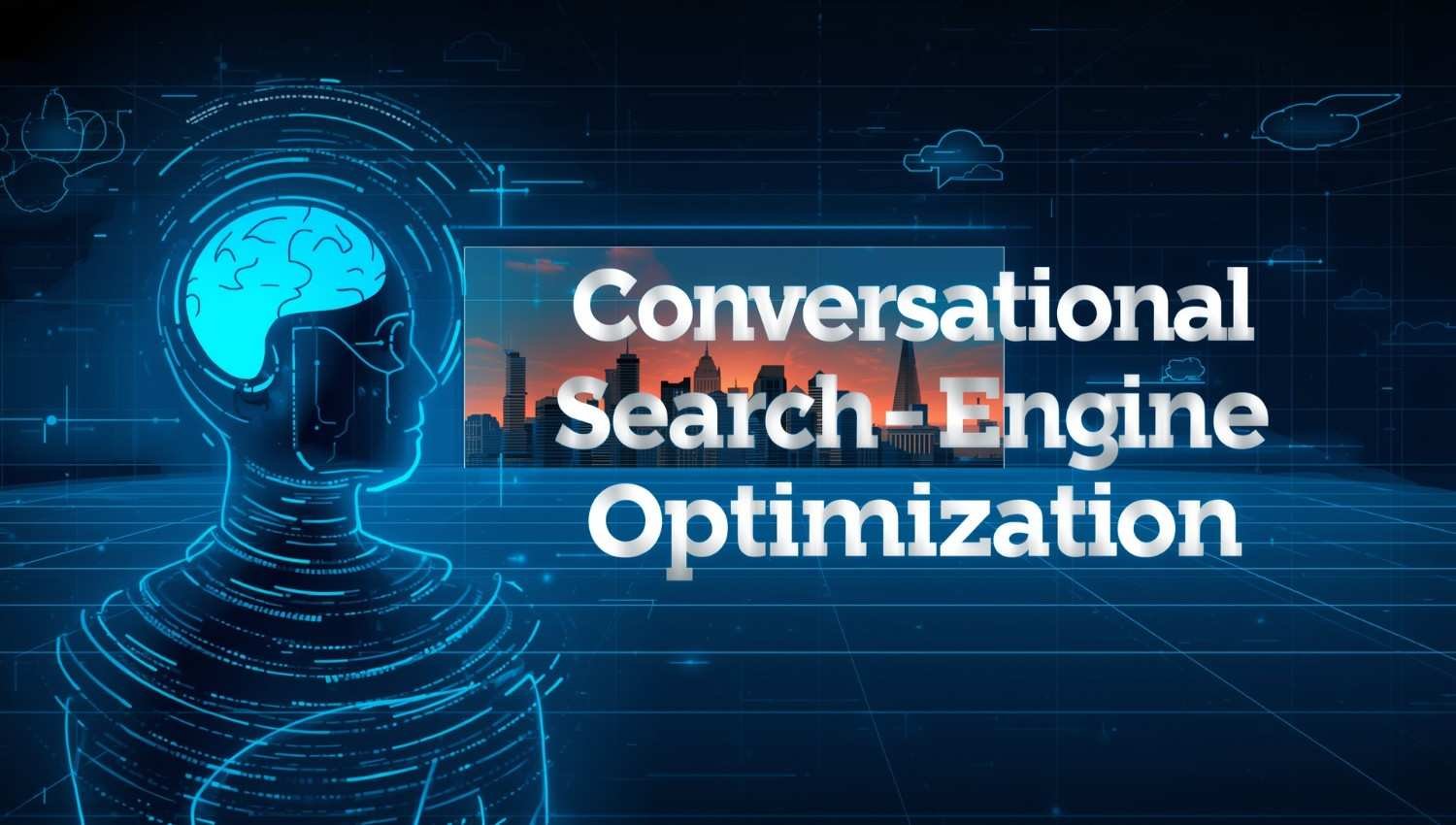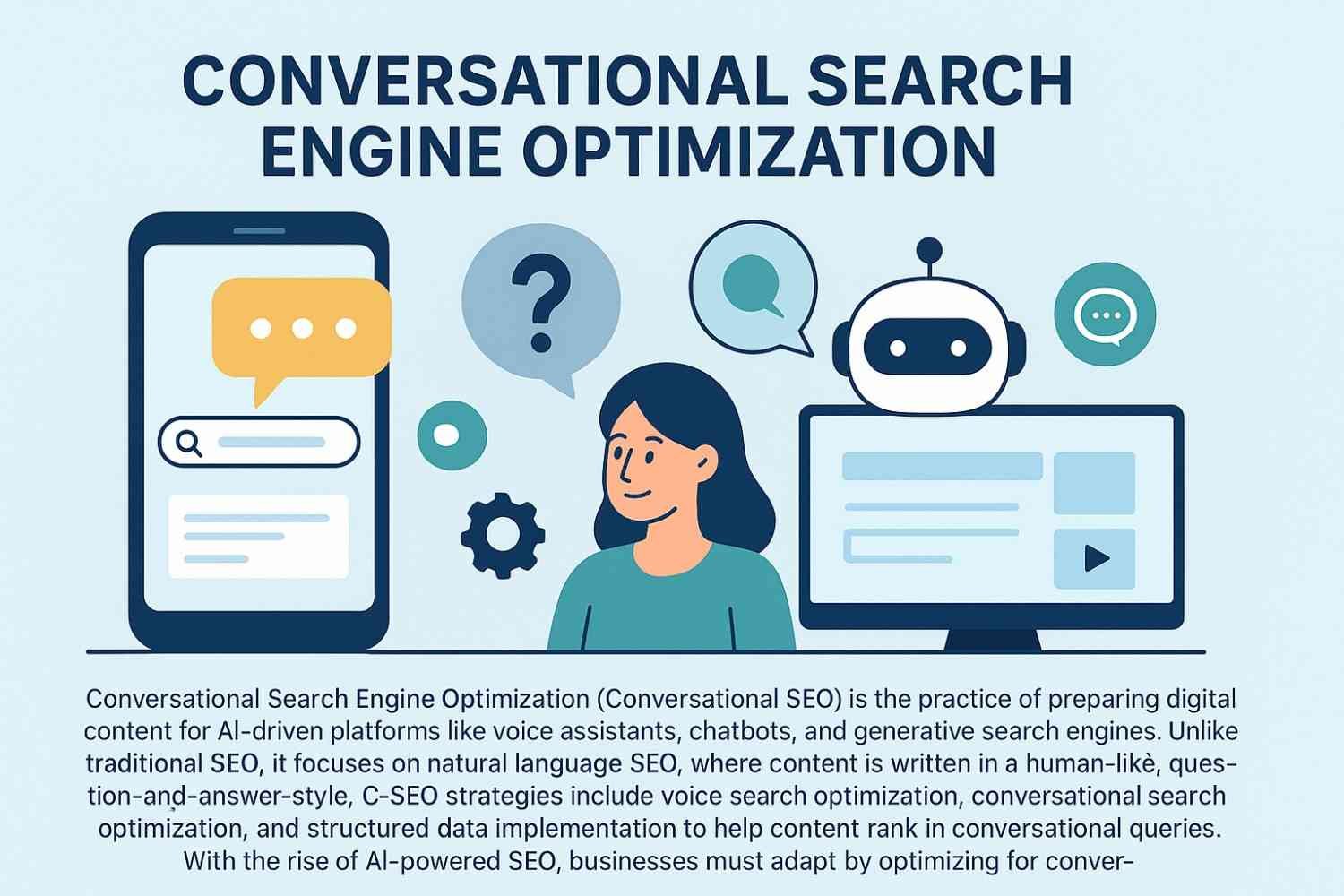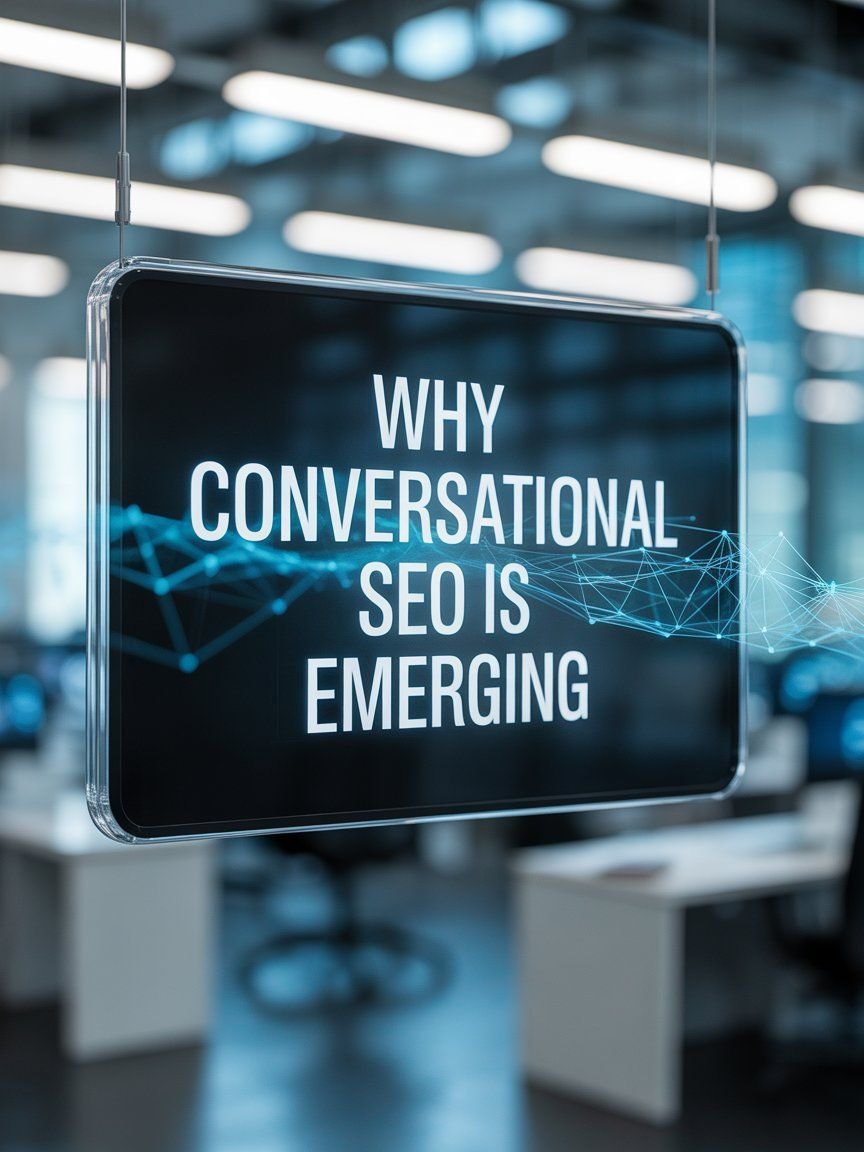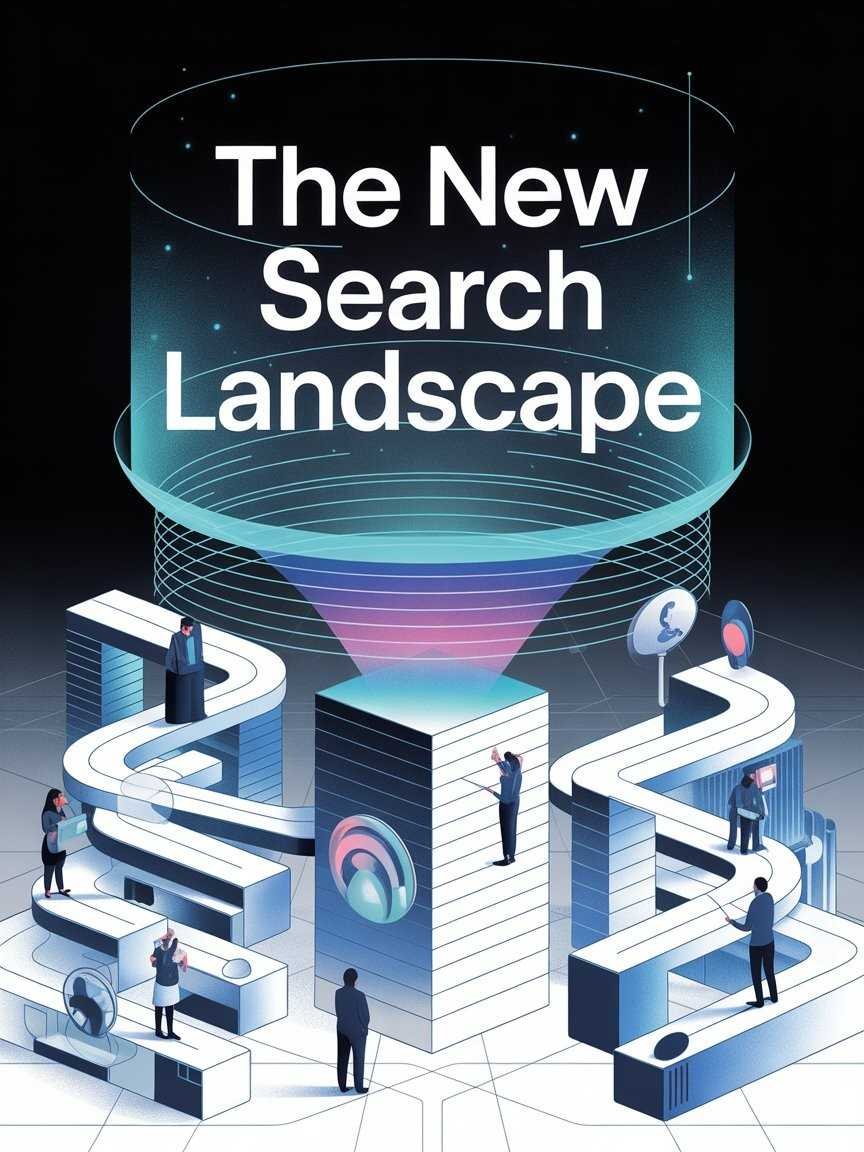Conversational Search engine optimisation
Conversational Search Engine Optimization (Conversational SEO) is the practice of preparing digital content for AI-driven platforms like voice assistants, chatbots, and generative search engines. Unlike traditional SEO, it focuses on natural language SEO, where content is written in a human-like, question-and-answer style. C-SEO strategies include voice search optimization, conversational search optimization, and structured data implementation to help content rank in conversational queries. With the rise of AI-powered SEO, businesses must adapt by optimizing for conversational search so their websites can appear in results delivered by AI chatbots and voice devices. This shift ensures visibility, relevance, and engagement in the new era of search.
Conversational Search Engine Optimisation (C-SEO) adapts your content for AI-powered platforms. See how conversational search engine optimisation increases reach through natural, question-based search queries.

Conversational Search Engine Optimisation (C-SEO) is the future of digital visibility. Learn how C-SEO helps websites rank in voice search, AI-driven results, and chatbot answers by optimising for natural, human-like queries.
Conversational Search Engine Optimisation: The Future of Search
Conversational Search Engine Optimisation (C-SEO) is an evolving approach to digital marketing that focuses on how people naturally ask questions through voice assistants, chatbots, and generative AI search tools. Unlike traditional SEO, which primarily targets keyword-based search queries, conversational SEO prepares content to be understood and delivered in real-time, human-like answers.
The growth of smart devices, AI assistants like Siri, Alexa, and Google Assistant, and generative AI platforms such as ChatGPT, Bing Copilot, and Google AI Overviews has made this optimisation strategy increasingly important. Instead of typing short keywords, users now speak or type full questions like “What’s the best running shoe for flat feet?” or “How do I optimise my site for AI search?” C-SEO ensures your content is discoverable for these kinds of queries.

Why Conversational SEO Matters
Today’s search landscape is shifting. Voice search adoption is rising globally, and AI-driven search engines are rewriting how results are presented. Instead of a list of blue links, users often see a direct, conversational answer at the top. If your content isn’t optimised for this new style, you risk being overlooked even if your website ranks well traditionally.
Conversational search engine optimisation helps brands adapt by making their content:
1.More natural – Written in a Q&A style to match how people ask questions.
2.Structured for AI – Using schema markup and clear headings so AI can extract precise answers.
3.Voice-friendly – Short, clear responses that can be read aloud by assistants.
4.Contextual – Addressing user intent, not just keywords.
Core Strategies of C-SEO
To succeed with conversational search optimisation, businesses should:
- Target long-tail, natural queries: Instead of “best shoes,” focus on “What are the best shoes for marathon beginners?”
- Optimise for voice search: Create bite-sized answers that can be spoken clearly.
- Use structured data: Schema helps AI systems identify and cite your content.
- Adopt a conversational tone: Write content in the same way people speak.
- Answer questions directly: Provide clear, helpful, and accurate responses.
The Business Impact of Conversational SEO
C-SEO is not just about search rankings; it’s about visibility in the next generation of digital platforms. When your content is cited by Google’s AI Overview or read aloud by Alexa, your brand gains trust and authority instantly. This shift also creates new opportunities for local businesses, since many conversational searches are location-based (e.g., “Where’s the nearest vegan restaurant open now?”).
By investing in conversational search engine optimisation, companies future-proof their digital presence. As search evolves from static keywords to dynamic conversations, C-SEO ensures your business stays ahead of the curve.
1. Conversational Search Engine Optimization
The practice of optimizing websites and content so they can be discovered, understood, and featured in AI-driven conversational searches, such as voice assistants and AI chat results.
2. Conversational SEO
A short term for Conversational Search Engine Optimization, focusing on natural, question-based queries and human-like content to match how people actually speak.
3. C-SEO Strategies
Action plans and techniques used to implement Conversational SEO, including voice search optimization, structured data, long-tail keywords, and AI-friendly content formatting.
4. Conversational Search Optimization
Improving content to align with conversational queries like “What is the best…?” or “How do I…?” so AI and voice search tools can deliver precise answers from your website.
5. AI-Powered SEO
The use of artificial intelligence to both optimize content (through insights, automation, and keyword analysis) and ensure visibility in AI-powered search engines and assistants.
6. Voice Search Optimization
Adapting content for spoken queries on devices like Google Assistant, Alexa, or Siri by focusing on natural phrasing, local SEO, and concise answers.
7. SEO for AI Chatbots
Optimizing digital content so it can be cited or used by AI chatbots (like ChatGPT or Bing Copilot) when generating answers to user questions.
8. Natural Language SEO
An approach to SEO that prioritizes human-like, conversational language in content instead of keyword stuffing, making it more relevant to AI and voice search engines.
9. Optimizing for Conversational Search
The process of structuring content, FAQs, and schema so it matches how people ask questions naturally, increasing chances of being selected by AI search engines.
1. What Is Conversational SEO (C-SEO)?
Conversational SEO (C-SEO) is the practice of shaping your content so AI-driven, chat- or voice-based “answer engines” can easily interpret it, extract precise passages, and cite your page inside their synthesized responses. Unlike classic SEO—which optimizes to rank blue links—C-SEO targets inclusion and attribution in results from systems like Google’s AI Overviews, Bing’s Copilot Search, and LLM assistants. Closely related concepts include Answer Engine Optimization (AEO)—formatting content to be the direct answer—and Generative Engine Optimization (GEO)—tuning content so generative systems surface and credit it more often.
Why It’s Emerging Now
The emergence of conversational seo is tied to a visible shift in search UX: synthesized, conversational summaries with source links appear before traditional listings, and voice/AI interfaces route users through dialogue rather than paginated SERPs. Microsoft positions Copilot Search explicitly as a summarized-answer experience with cited sources, while Google’s AI Overviews/AI Mode increasingly places consolidated answers at the top. This changes what it means to “win” a query—being included and attributed inside the AI answer can matter as much as rank.

What Early Benchmarks Say (Effectiveness vs. Traditional SEO) in conversational seo
Early, mixed evidence suggests C-SEO tactics are promising but not consistently superior to classic SEO fundamentals. Independent analyses show AI summaries can reduce click-through to traditional results for many informational, non-branded queries, implying a tougher fight for traffic even when you’re cited. At the same time, Google argues overall outbound clicks remain relatively stable year over year, with distribution varying by site type—especially where forums, video, and original content grow. Bottom line: treat C-SEO as an adjacent layer, not a replacement; authority, crawlability, and high-quality content still drive the most reliable outcomes.
Q.How Conversational search Engines Select & Cite Content?
Answer engines appear to reward passage-level clarity (FAQs, definitions, step lists), entity precision (clear people/places/things), and evidence density (stats, sources, quotations) that make extraction and attribution straightforward. GEO research frames this as optimizing the visibility metric you care about (e.g., being named, linked, or ranked inside an AI panel) and iterating toward structures that models consistently lift into answers. Practically, this favors tightly structured sections embedded in longer expert pieces—so a comprehensive guide still wins authority, while its scannable blocks power the citation.
Practical Playbook (What to Do Now)
- Design for answers inside articles. Embed FAQ blocks, concise definitions, procedural steps, pros/cons, and short takeaways so models can lift self-contained snippets with context. Pair these with in-depth coverage to preserve topical authority.
- Strengthen entity & evidence signals. Use specific names, figures, dates, and outbound citations. This improves factual grounding and extractability in generative answers. GEO literature emphasizes optimizing toward your desired attribution outcomes.
- Implement appropriate schema. Where relevant, add FAQPage/HowTo/Article schema and maintain clean internal linking so crawlers and AI retrievers can map sections to intents.
- Mind the ecosystem you’re feeding. Bing Copilot and enterprise copilots detail how knowledge sources are ingested; aligning your public pages and documentation hierarchy with those expectations improves inclusion odds.
Measurement in the C-SEO Era
Beyond rank, track:
- Inclusion Rate: how often your domain appears (linked or named) inside AI summaries.
- Citation Share/Position: how prominent your link is among cited sources.
- Answer Stability: how often inclusion persists across weeks.
- Zero-Click Impressions vs. Clicks: whether your inclusion actually drives visits.
Pair these with controlled keyword sets and periodic snapshots to see how AI Overviews/Copilot behavior changes over time; multiple third-party studies show that presence in summaries can depress traditional CTRs—so your KPIs must capture visibility inside the answer, not just SERP position.
Traffic Reality & Publisher Response
Publishers report uneven outcomes: some lose discoverability when AI answers satisfy intent without a click, while others gain when their communities, videos, or original research are preferentially surfaced. This has sparked a wider “grand bargain” debate—balancing open access with compensation and controls (e.g., selectively blocking AI bots or licensing data). Expect more defensive crawling policies and negotiations as models scale their reliance on publisher content.
The Road Ahead
Short term, anticipate volatility as answer UX evolves and methodologies for measuring attributed inclusion mature. Google maintains that outbound clicks overall are stable, but independent datasets still show lowered CTR when summaries appear—so the prudent posture is hybrid: keep compounding traditional SEO moats while iterating GEO/AEO patterns that demonstrably boost inclusion and referral quality from answer engines. Teams that instrument these signals early will adapt fastest as the interface of search continues to shift.

2) The New Search Landscape conversational seo-
Search is no longer just a list of blue links — it’s moving toward conversational, synthesized answers that aim to resolve intent inside the results page or a chat window. This shift underpins the emergence of conversational seo: content creators must now compete to be included and attributed inside AI summaries (AI Overviews, Copilot replies, etc.), not only to rank for top organic positions. The shift changes how users discover information (fewer intermediate clicks), how publishers earn attention, and how marketers measure success.

2.1 Who Are the “Conversational Engines Optimization”?
The major conversational engines today include Google Search’s AI Overviews / AI Mode, Microsoft’s Bing Copilot and Microsoft 365 Copilot integrations), and several LLM-powered assistants and answer-first startups that aggregate and synthesize web content. Each product has a slightly different UX and attribution model — Google emphasizes AI Overviews with “helpful links,” Bing Copilot blends chat answers with visual/interactive elements and visual search, and enterprise copilots (Microsoft 365, Slack, etc.) often pull from internal knowledge bases. New entrants (Perplexity, others) focus purely on short, sourced answers. If you’re optimizing content now, you must think about how each engine ingests sources and surfaces citations.
Example (visual): Google’s blog screenshots show AI Overviews presenting a concise summary at the top of results with links; Bing Copilot demos show chat-style replies and visual search options; third-party analyses illustrate how different interfaces highlight sources differently.
2.2 What’s Changing in SERPs?
Two visible changes in SERPs are (a) AI-first summaries appearing above or alongside traditional listings, and (b) reduced click-through for many informational queries where the answer satisfies the user. Multiple independent studies and reports in 2024–2025 find that when AI Overviews appear, users click external organic links substantially less often (some analyses show CTR declines in the high single to double digits for non-branded informational queries). At the same time, Google maintains that total outbound clicks are “relatively stable” overall, suggesting effects vary by vertical, query type, and content format. In short: the presence of an AI summary often diverts traffic that would previously have flowed to the top organic result — but impact is uneven.
Example (visual): Industry charts comparing CTR before/after AI Overviews show pronounced drops for informational queries; screenshots of SERPs demonstrate how summaries occupy prime screen real estate.
2.3 Industry Debate: Is AI Killing or Growing Search?
The industry is split. Some publishers and studies warn of “devastating” traffic losses when AI summaries replace clicks (reporting declines of up to ~70–80% for certain pages in some studies), prompting concerns about publisher revenue and the need for compensation or licensing. Other voices — including Google — argue that AI features can improve search utility and that total click volume hasn’t collapsed; they point to new types of engagement and referral flows (e.g., more discovery of videos, community posts, or branded content in certain contexts).
Example (visual): News coverage and industry reports show both outraged publisher case studies and counterarguments from platforms — a useful collage for understanding why the debate remains unsettled.
3) Evidence Check: Does C-SEO Work?
The emergence of conversational seo has triggered a wave of testing to see if optimizing for AI-generated answers truly delivers better results than traditional SEO. While the promise is appealing — earning citations directly in AI Overviews, Bing Copilot replies, and LLM assistants — independent research shows that the reality is mixed, and the gains aren’t guaranteed.
3.1 The C-SEO Bench Study (2025)
A large-scale, multi-domain benchmark published in mid-2025 evaluated a variety of C-SEO tactics across industries. The results were sobering:
- Most current C-SEO techniques showed little or no measurable improvement in being included or cited by conversational engines.
- Traditional SEO fundamentals — high rankings, strong authority signals, and quality backlinks — still outperformed experimental C-SEO methods in driving inclusion and citations.
- Competitive adoption led to zero-sum congestion effects: once many players in a niche applied the same C-SEO tactics, the relative advantage disappeared.
Example (visual):
The chart below (from the study) shows inclusion rates for different strategies — with traditional SEO (blue) outperforming C-SEO-only approaches (orange) across test queries.
3.2 Earlier GEO Findings
Before the 2025 benchmark, Generative Engine Optimization (GEO) research suggested there were measurable gains to be had:
- Some optimization methods (e.g., structured data, concise answer blocks, entity clarity) boosted visibility in AI answers by up to ~40% in specific verticals such as technical documentation or niche product queries.
- However, these results weren’t universal — replication across different topics, formats, and search engines showed wide variation.
- Over time, as more publishers adopted similar tactics, the advantage narrowed, echoing the saturation problem seen in SEO over the past decade.
Example (visual):
Side-by-side screenshots of Bing Copilot answers show one version without targeted optimization and another after implementing FAQ schema and concise, evidence-rich snippets — with the optimized version gaining direct citation.
3.3 What This Means for Marketers in conversational seo
For marketers, the takeaway is clear:
- Treat C-SEO as an additional layer, not a replacement for proven SEO. The engines still rely heavily on the same fundamentals — authority, relevance, technical optimization — when selecting sources.
- Use C-SEO tactics (FAQ sections, entity-rich writing, schema markup) to increase the likelihood of being cited in conversational results, but don’t abandon ranking strategies for traditional SERPs.
- Monitor inclusion rate, citation share, and traffic quality from AI-generated answers — not just organic rank — to see if C-SEO is delivering ROI in your specific market.
Example (visual):
A funnel diagram illustrating how a hybrid strategy works:
- Traditional SEO brings qualified traffic via SERPs.
- C-SEO increases mentions and links inside AI answers.
- Together, they maximize visibility in both old and new search interfaces.
4) How Conversational Engines Choose Content
Conversational engines don’t “rank pages” the same way classic search did — they retrieve, synthesize, and present passage-level answers using retrieval and large language model synthesis. The emergence of conversational SEO means content creators must be prepared for models to pick concise, evidence-rich snippets from anywhere on a page (or across pages) and stitch them into a single response. Practical selection therefore depends on two things: (A) what the retriever considers a highly relevant passage and (B) what the generator can reliably use without hallucinating.
4.1 Selection Signals Likely in Play
Conversational engines appear to prefer passages and sources that combine several signals:
- Topical authority: pages or domains with a clear, demonstrable subject-matter history are more likely to be retrieved and trusted.
- Clear structure & scannability: short, self-contained blocks (FAQ Q→A, numbered steps, TL;DR summaries) are easier to extract as coherent answers.
- Factual density & citations: passages with concrete facts, dates, numbers, and outbound references are less likely to be filtered out for low confidence.
- Entity clarity: clearly named people, products, places, or concepts (consistent metadata, schema, H-tags) help retrievers match queries to the right passages.
Example image (selection signals): screenshot illustrating a well-structured FAQ block and bolded stats that a retriever could lift.
- Caption: “Passage-level clarity — concise Q&A and fact callouts increase extractability.”
- Alt text: “Article excerpt showing an FAQ block with bold statistics and a concise one-sentence answer.”
4.2 From Pages to Passages
Historically, SEO optimized whole pages for keyword relevance; conversational engines increasingly operate at the passage level. That means a long, authoritative article can succeed two ways: by providing overall topical depth (authority) and by containing multiple excerptable passages (FAQ, definitions, steps) that answer specific intents. Passage-level success requires:
- Self-contained snippets: a single paragraph that answers a clear question without needing surrounding context.
- Concise framing: short headers and lead-in sentences that make intent explicit.
- Consistent signals across the site: the same entity names, author credentials, and schema reinforce which passages belong to authoritative sources.
Example image (pages → passages): side-by-side SERP mock showing a full article in organic results versus the same article’s FAQ passage quoted inside an AI Overview.
- Caption: “AI Overviews often lift short passages from long guides — structure makes the difference.”
- Alt text: “Comparison showing a long-form article in search results and a highlighted passage extracted into an AI summary.”
4.3 The Role of Attribution
Attribution practices vary by platform, but most conversational engines now include source links or citations alongside synthesized answers. However, the presence of a citation does not guarantee a click — many citations point to high-level references and users may not leave the conversation.
Key points:
- Links still matter — engines use link and domain signals when constructing trust and when choosing which sources to cite. Strong backlink profiles and authoritative host signals improve citation odds.
- Citation ≠ traffic parity — when AI summaries appear, users often click out to external sites far less than before; being cited can raise visibility and brand recognition but may not restore prior click-through rates.
- Platform differences — some engines show different citation behaviors and source mixes; optimizing for attribution means monitoring which engines matter to your audience and tailoring source signals accordingly.
Example image (attribution): screenshot of an AI Overview with multiple cited sources beneath the summary.
- Caption: “AI Overviews typically attach cited links — but clicks vary by engine and query type.”
- Alt text: “AI-generated summary at top of search results with three cited source links shown beneath.
5) Tactical Playbook: Blending Traditional SEO + C-SEO
The emergence of conversational SEO has created a new optimization layer on top of traditional search practices. Winning visibility now means balancing long-form, authority-driven content with concise, answer-ready snippets that conversational engines can easily extract and present. This tactical playbook focuses on blending both worlds for maximum reach.
5.1 Content Design for Answers
Conversational engines thrive on clear, self-contained answer formats. Embedding these within longer articles ensures your page can rank in organic search while also being excerpted in AI-driven results.
- FAQ blocks: Direct Q&A format aligned to searcher questions.
- How-to steps: Ordered lists with numbered steps make retrieval easy.
- Pros/cons lists: Balanced perspectives signal credibility and help models summarize quickly.
- Checklists: Compact, scannable action points for user intent completion.
- Concise definitions: One- or two-sentence explanations at the start of sections.
Example image: An article showing a step-by-step guide block inside a long-form blog.
- Caption: “Embedding answer-ready sections inside in-depth articles serves both SEO and C-SEO.”
- Alt text: “Highlighted block in a blog post showing an FAQ and checklist format.”
5.2 Evidence-Rich Writing
LLM-powered engines prioritize content that looks authoritative and verifiable. That means every claim should be backed by data, quotes, or recognized entities.
- Stats and figures: Numbers anchor confidence.
- Expert quotes: Credible voices reinforce authority.
- Named entities: Clearly identify products, organizations, and locations to help engines match queries.
- Specific examples: Real-world case studies add contextual depth.
Example image: A blog snippet with bolded statistics and a cited expert name.
- Caption: “Evidence-rich writing increases both extractability and trust.”
- Alt text: “Paragraph with highlighted statistics and an expert attribution.”
5.3 Structured Data & Technical Hygiene
Technical optimization remains crucial. Structured data helps conversational engines understand and categorize your content for both ranking and answer generation.
- FAQ and HowTo schema: Mark up answer-ready content for better retrieval.
- Clean information architecture (IA): Logical menus, headings, and categories.
- Fast performance: Slow-loading pages risk exclusion from quick-response engines.
- Crawlability & robots controls: Ensure both search bots and AI-specific crawlers can index your content.
Example image: Screenshot of schema markup code paired with a visible FAQ section in search results.
- Caption: “Schema markup guides engines in recognizing content structure.”
- Alt text: “HTML schema code snippet with a preview of a rich result.”
5.4 Entity & Brand Signals
Conversational search depends heavily on entity resolution — understanding who or what is being referenced.
- Consistent brand mentions: Uniform naming across site and profiles.
- Author bios: Clear credentials tied to each piece of content.
- Organization schema: Signals brand legitimacy to engines.
- Cross-platform consistency: Keep brand details identical on social, directories, and media appearances.
Example image: Diagram showing a brand’s name, logo, and author profile connected across multiple platforms.
- Caption: “Consistent entity signals make engines more confident in sourcing your content.”
- Alt text: “Flow diagram linking brand entity data across web properties.”
5.5 Content Portfolio Strategy
The most resilient approach blends traditional SEO authority building with conversational extractability.
- In-depth evergreen content: Builds topic authority.
- Answer-ready snippets: Boosts inclusion in AI summaries.
- Original formats: Forums, videos, and podcasts are gaining traction in search visibility.
- Diversified reach: Different formats reach different segments and query types.
Example image: Content calendar showing a mix of long-form guides, short FAQs, videos, and podcasts.
- Caption: “Balanced content portfolios perform better across both traditional and conversational search.”
- Alt text: “Editorial calendar with mixed content formats and publishing dates.”
Bottom line: The emergence of conversational SEO doesn’t replace traditional SEO — it enhances it. Success comes from producing authoritative, evergreen material while layering in structured, answer-friendly formats that conversational engines can easily surface and trust.
6) Measurement in the C-SEO Era
As the emergence of conversational SEO reshapes discovery, old measurement frameworks (rank + organic clicks) aren’t enough. Successful teams instrument both visibility inside AI answers and downstream engagement so they know whether being cited by an engine produces real business value.
6.1 New KPIs to Track
- Inclusion Rate — Percent of tracked queries in which your domain is mentioned, cited, or linked inside a conversational answer. This measures raw visibility inside AI-generated responses, independent of clicks.
- Citation Share / Position — When an AI answer lists multiple sources, track the share of citations your site receives and where your citation appears (primary source, secondary, supporting link). Higher placement usually correlates with greater perceived authority.
- Answer Stability Over Time — How often your inclusion persists across repeated samplings (daily/weekly/monthly). Volatile inclusion suggests fragile signals or competitive churn; stable inclusion indicates durable authority for that intent.
- Zero-Click Impressions vs. Click-Throughs — Compare impressions where an AI answer included your citation but produced no click (zero-click) versus times it drove a visit. This reveals whether being cited increases brand reach only, or also drives downstream engagement and conversions.
- Engagement Quality from AI Referrals — If citations do drive visits, measure engagement metrics (time on page, pages per session, conversion rate) specifically for traffic from conversational-result referrals. The business value of being cited depends heavily on this quality.
Example visual widget: a dashboard mock showing four tiles — Inclusion Rate (percentage), Citation Share (pie), Answer Stability (line chart over time), Zero-Click vs Clicks (bar chart).
- Caption: “Measure both presence in AI answers and the engagement those citations produce.”
- Alt text: “Dashboard mock with KPIs: inclusion rate, citation share pie chart, stability line chart, zero-click vs clicks bar chart.”
6.2 Research-Inspired Testing
To know what moves the needle, run experiments modeled on research-grade methods:
- Controlled Query Sets — Build a representative list of intents (informational, transactional, navigational, long-tail) and measure inclusion and CTRs for each. Use the same query set repeatedly to detect changes.
- Competitor Adoption Scenarios — Simulate competitive saturation by tracking peers who adopt the same answer-focused changes. Watch for diminishing returns or zero-sum congestion effects when tactics are widely copied.
- A/B Content Tests for Passage Extractability — On the same canonical page, test a control (long-form only) versus a variant that adds short, self-contained answer blocks (FAQ, TL;DR, numbered steps). Measure changes in inclusion rate and referral engagement.
- Longitudinal Tracking — Snapshot the query set at regular intervals (weekly/monthly) to capture volatility, seasonality, and engine-interface changes. Combine these snapshots into an “answer stability” series to identify durable wins.
- Attribution Segmentation — Segment traffic by source type: organic SERP, AI-answer referral, direct, social. Compare conversion rates and LTV to judge whether AI citations deliver equivalent or complementary value.
Example visual experiment layout: split-screen showing (A) control page and (B) variant page with added FAQ block; an adjacent chart shows inclusion rate lift and click conversion differences.
- Caption: “A/B test a passage-optimized variant to measure inclusion lift and conversion impact.”
- Alt text: “Split-screen of two page versions with a chart showing inclusion rate increase for the variant.”
7) Traffic Reality: Winners, Losers & Adaptation
The emergence of conversational SEO has introduced a redistribution of attention across the web: some queries are now resolved inside an AI answer without a click, while others still drive users to sites. Understanding who benefits, who loses, and how to adapt is essential for publishers and marketers.
7.1 When AI Overviews Help vs. Hurt
AI Overviews and chat-style answers most strongly affect non-branded informational queries—simple “what is” or “how to” questions where a short, authoritative snippet satisfies intent. In those cases, top-line click-through rates to external sites drop and sessions often end within the search interface. Conversely, branded, complex, or task-oriented queries (e.g., product comparison, deep research, transactional flows) tend to retain clicks because users need more context, verification, or action than a single summary can provide. In practice, this means some pages lose traffic volume but others (especially those offering unique data, interactive tools, or rich media) can maintain or even grow engagement.
Example image: Two side-by-side SERP screenshots — left: an AI Overview answering “what is X?” with no immediate click; right: a product-comparison query showing organic listings and clicks.
- Caption: “Informational queries often end in the AI answer; complex or branded queries still send users to sites.”
- Alt text: “Comparison of search results: an AI summary that answers a simple query versus a results page with multiple clickable listings.”
7.2 Publisher Economics & the “Grand Bargain”
The shift has sparked a heated debate about the web’s sustainability. Historically, publishers relied on referral traffic (the “grand bargain”) to monetize reporting and original content. With AI answers sometimes bypassing clicks, publishers argue their ad- and subscription revenues are threatened—prompting calls for licensing, pay-per-use models, or technical controls to block indiscriminate scraping by AI crawlers. At the same time, some publishers report net gains from AI-driven referrals when the platform surfaces their unique content, so outcomes vary by business model and content type. The likely near-term result is a patchwork of responses: negotiations, selective blocking or paywalls, and novel compensation experiments (pay-per-query, pay-per-crawl) as stakeholders try to rebalance value.
Example image: Infographic showing three publisher responses — negotiate licensing, block/limit crawlers, or diversify revenue — with pros/cons for each.
- Caption: “Publishers are choosing between licensing deals, technical blocks, or diversifying revenue as responses to AI-driven redistribution.”
- Alt text: “Infographic listing publisher strategies: licensing, blocking crawlers, diversify content revenue.”
7.3 Channel Mix Update
Because conversational results can reduce referral clicks for certain query types, diversifying discovery is more important than ever. Publishers and brands should expand beyond organic search into channels that conversational engines currently surface less directly or that build owned audiences:
- Email & Newsletters: Direct relationship channels that deliver repeat engaged traffic.
- Communities & Forums: Niche audiences that provide discoverability and long-tail engagement.
- YouTube & Podcasts: Rich media formats that are increasingly surfaced in search and favored by AI summaries for certain query types.
- Social Platforms & Video Short-Form: Drive brand awareness and alternative referral pathways.
A balanced channel mix reduces dependence on any single source and gives companies leverage when negotiating with platforms or experimenting with C-SEO. Track outcomes by channel and measure whether AI citations substitute for visits or complement them (e.g., increased brand searches, newsletter signups).
Example image: A content distribution matrix showing traffic contribution percentages from organic search, AI referrals, email, social, and video.
- Caption: “A diversified channel mix mitigates potential traffic loss from AI summaries and strengthens audience ownership.”
- Alt text: “Matrix chart showing percentage contributions of channels: search, AI, email, social, video.”
8) Governance, Legal & Ethics
As the emergence of conversational SEO accelerates, concerns around the ethical use of content, fair compensation, and the legal mechanics governing AI access are moving front and center. Publishers and AI platforms alike are scrambling to define responsible norms in this fast-evolving landscape.
8.1 Data Usage & Robots Policies in conversational SEO
Publishers are deploying technical measures—including robots.txt rules, AI bot blocking tools, and rate-limiting—to curb unauthorized scraping by AI models. Infrastructure providers are responding: some now enable AI crawler blocking by default, shifting control back to content creators. Others are exploring pay-per-crawl frameworks, letting publishers charge AI systems for access. These moves acknowledge that the old assumption—“everything public is freely usable”—no longer holds in the age of AI synthesis.
Example image: A graph showing publisher adoption of AI bot-blocking tools over time, with an overlay of “pay-per-crawl” policy toggle buttons.
- Caption: “Publishers are deploying technical defenses like AI bot blocks and pay-per-crawl options to control access amid the rise of conversational SEO.”
- Alt Text: “Chart of increasing publisher AI bot-blocking adoption with UI toggle for pay-per-crawl controls.”
8.2 Attribution & Fair Compensation
Beyond defense, many publishers are pursuing new compensation models that reward usage proportionally. Attribution platforms calculate exactly how much content contributes to an AI-generated answer and then share a percentage of revenue with the publisher—sometimes as much as 50% on a per-use basis. Industry groups are also developing standards and APIs to formalize this value exchange. Meanwhile, academic and professional entities are calling for transparent frameworks—FAIR AI Attribution standards, metadata disclosures, and fair-use guidelines—to reinforce trust and ensure ethical content use.
Example image: A flow diagram illustrating how an AI answer engine attributes content usage and distributes revenue among publishers.
- Caption: “Emerging attribution systems allocate revenue based on content contribution—recognizing value in the era of conversational SEO.”
- Alt Text: “Diagram showing content attribution flow from AI-generated answers to publishers with proportional revenue sharing.”
Bottom line: The emergence of conversational SEO is not just a technical shift—it’s reshaping norms around access, ownership, and value. Publishers are combining defensive controls with value-sharing mechanisms, while ethical frameworks and technical standards begin to crystallize. Together, these forces are defining what responsible content usage looks like in the AI era.
9) The Road Ahead
The emergence of conversational SEO marks a pivotal shift in how search works, but the future is far from settled. AI-powered overviews, answer engines, and chat-driven search are influencing click patterns, revenue distribution, and long-term content strategies. The next two years will be a blend of opportunity, uncertainty, and strategic experimentation.

9.1 What Google Says Will Happen Next
Google’s position is clear: AI Overviews (and AI Mode) will increase search usage by making results more helpful and accessible, particularly for complex queries. The company insists that “links to the web remain central,” meaning publishers will still benefit from visibility in AI-driven results.
Example image: Side-by-side mockup of a traditional SERP and an AI Overview, with highlighted “source links” in the AI answer box.
- Caption: “Google predicts AI Overviews will drive more searches while keeping source links visible.”
- Alt text: “Comparison between traditional Google results and AI Overview showing cited sources.”
9.2 What Independent Data Suggests
Independent studies paint a mixed picture. Some publishers report declines in click-through rates (CTRs) for informational queries—especially non-branded ones—due to “zero-click” answers. Others see stable or even improved performance in niches where AI summaries act as discovery gateways. Revenue impact is also inconsistent: ad-heavy sites often feel the pinch, while authority-driven content benefits from citations in AI overviews.
Example image: Bar chart showing CTR change for different query types: branded (+2%), how-to (0%), generic informational (-8%).
- Caption: “Independent data shows CTR shifts vary greatly depending on query type.”
- Alt text: “Chart of CTR percentage changes across query types in the era of AI search.”
9.3 Practical Stance for 2025–2026
Marketers should treat conversational SEO as an add-on layer, not a replacement for traditional SEO. Keep ranking factors strong—authority, backlinks, and technical performance—because AI models still pull from the same trusted sources. Layer in C-SEO tactics such as:
- Creating passage-friendly content (clear definitions, steps, and concise answers).
- Strengthening entity consistency (brand, author, organization details).
- Tracking inclusion rates and AI citation patterns as closely as keyword rankings. At the same time, build owned audiences through newsletters, communities, podcasts, and video channels—reducing reliance on any single search engine’s behavior.
Example image: Flow diagram showing a dual-strategy approach—traditional SEO feeding AI inclusion, and owned audience channels supporting resilience.
- Caption: “Future-ready search strategy blends strong traditional SEO, C-SEO optimization, and direct audience building.”
- Alt text: “Diagram showing traditional SEO, conversational SEO, and owned channels working together.”
-
- Answer questions directly – Write clear, concise responses in 1–3 sentences.
- Use conversational headings – Example: “How does conversational SEO work?”
- Optimise for voice search – Use natural language, long-tail keywords, and FAQs.
- Implement structured data – Schema helps AI engines extract precise answers.
- Create scannable content – Use lists, tables, and short paragraphs.
- Appear inside AI-generated summaries.
- Be cited as a trusted source.
- Capture traffic even when users don’t click through to websites.
Why Is Conversational SEO Important in 2025?
With more users asking full questions like “How do I optimise for voice search?” instead of typing short keywords, AI search engines are shifting to conversational intent. If your content is optimised for natural language, it’s more likely to:How to Optimise Content for Conversational SEO
Here are the best practices for C-SEO:
- FAQs on Conversational SEO
Q1. How is Conversational SEO different from traditional SEO?
Traditional SEO aims to rank a page in Google’s top 10 results. Conversational SEO focuses on making content useful for AI-driven answer engines, where natural language and contextual answers matter more than exact-match keywords.Q2. Does Conversational SEO replace keyword optimisation?
No — keywords still matter. But instead of short keywords, focus on long-tail, natural phrases that mimic how users ask questions in real life.
Powerful Strategies for Conversational SEO (C-SEO) in 2025
- Discover 7 powerful strategies for Conversational SEO (C-SEO) in 2025 to optimise your content for AI search, voice assistants, and chatbots.
- Learn 7 proven Conversational SEO (C-SEO) strategies in 2025 to boost visibility in AI-driven search results and conversational queries.
- Unlock 7 effective Conversational SEO (C-SEO) techniques for 2025 to rank in Google AI Overviews, Bing Copilot, and voice search.
- Get 7 actionable Conversational SEO (C-SEO) tips for 2025 to optimise your content for natural language and AI-powered search engines.
- Master 7 Conversational SEO (C-SEO) strategies in 2025 to stay ahead in AI search, voice optimisation, and chatbot visibility.
Example with Internal Links Added
In What Is Conversational SEO (C-SEO)? section:
👉 “Unlike traditional SEO strategies, which focus on ranking in the top 10 blue links, Conversational SEO ensures your content is AI-friendly.”In Why Conversational SEO Matters in 2025 section:👉 “With the rise of voice search optimisation, conversational queries are becoming the new normal.”In Strategy 3: Target Long-Tail Keywords section:
👉 “You can also combine Conversational SEO with long-tail keyword research to capture high-intent traffic.”In Strategy 6: Use Structured Data section:
👉 “Check out our full guide to schema markup to implement structured data effectively.”In Final Thoughts section:
👉 “To learn more, explore our article on AI-driven search trends.”
Powerful Strategies for Conversational SEO (C-SEO) in 2025
What Is Conversational SEO (C-SEO)?
Conversational SEO, also known as C-SEO, is the process of optimising content so that AI-driven search engines, voice assistants, and chatbots can easily understand and deliver it in a natural, human-like way. Instead of short keyword stuffing, it focuses on answering real questions in the same style people ask them.
Why Conversational SEO Matters in 2025
In 2025, search is no longer limited to the top 10 blue links. Platforms like Google AI Overviews, Bing Copilot, and ChatGPT Search deliver direct, conversational answers. If your content is not optimised for natural language queries, you risk being invisible.
By using Conversational SEO, your brand can:
- Appear in AI-generated responses.Gain visibility in voice search results.Build trust by being cited as a credible source.Strategies to Optimise for Conversational SEO
1. Use Conversational SEO for Voice Search Optimisation
Voice queries are longer and more natural. Example: instead of “best SEO tools”, users say “What are the best SEO tools for small businesses in 2025?”. Optimise for question-based keywords and ensure your answers are concise and easy to read aloud.
2. Write in a Natural, Question-and-Answer Style
Conversational SEO thrives on Q/A formatting. Use headings like “What is…?”, “How does…?”, “Why should…?”. This structure makes your content ready for AI engines to extract answers quickly.
3. Target Long-Tail Keywords for Conversational SEO
AI and voice search rely heavily on long-tail, intent-rich queries. Instead of just “SEO trends”, aim for “What are the top SEO trends for small businesses in 2025?”. These queries bring in higher-quality traffic and improve AI search visibility.
4. Optimise Content for AI Search Engines and Chatbots
Conversational SEO isn’t just for Google. Your content should also be discoverable in ChatGPT, Perplexity, and Bing Copilot. Make your content scannable with lists, bullet points, and structured definitions that AI models can extract.
5. Add FAQs with Conversational SEO Keywords
An FAQ section is one of the best ways to align with conversational queries. Each FAQ acts as a mini content snippet that directly answers user intent. Include your focus keyword naturally within the questions and answers.
6. Use Structured Data to Support Conversational Search Optimisation
Schema markup (like FAQ schema, HowTo schema, Article schema) helps AI-driven platforms interpret your content. Structured data increases the chances of being featured in AI overviews, snippets, and voice answers.
7. Monitor AI Overviews & Conversational SEO Performance
SEO in 2025 means monitoring how your content is cited in AI-driven search. Track mentions in Google AI Overviews, Bing Copilot, and voice search devices. Adjust your content strategy based on which answers are being pulled from your pages.
FAQs on Conversational SEO
Q1. How is Conversational SEO different from traditional SEO?
Traditional SEO focuses on ranking web pages in the top 10 results. Conversational SEO ensures your content is structured so AI engines and chatbots can use it directly in their answers.
Q2. Do I still need keywords in Conversational SEO?
Yes — but instead of short keywords, focus on long-tail, question-based keywords that sound like natural human speech.
Q3. Can Conversational SEO improve voice search ranking?
Absolutely. Voice assistants like Alexa, Siri, and Google Assistant rely on natural language answers — exactly what Conversational SEO provides.
Final Thoughts on Conversational SEO in 2025
Conversational SEO is no longer optional — it’s the future of search optimisation. By focusing on natural language, long-tail queries, and structured answers, you make your content accessible to AI-driven platforms, chatbots, and voice assistants.
If you apply these 7 Conversational SEO strategies in 2025, your content will stay visible, relevant, and ready for the AI-powered search era.
for morepost don’t forget to visit http://onlinedigigyan.com




